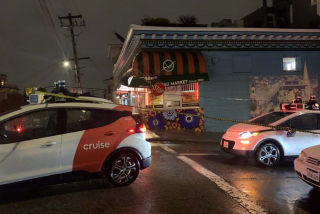Consider Cruise Ship Safety Standards When Making Vacation Decisions
- Share via
Last month’s images of the Oceanos taking a nose dive into the storm-tossed Indian Ocean off South Africa made all of us shudder. If you are booked on an upcoming cruise, you may well be asking, “Could it happen to me?” It’s not an unreasonable question.
Just how safe is cruising?
As might be expected, the International Council of Cruise Lines, a trade association representing many of the world’s major cruise lines, says cruising is quite safe. The answer, however, is somewhat more complex. When choosing a cruise, travelers should be aware of two important safety factors:
* The newest cruise ships generally are equipped with the most modern safety devices. Older cruise ships--and many of the vessels sailing from U.S. ports were built 20 or more years ago--are not required to adhere to all the latest international safety requirements.
* Cruise ships that sail regularly from U.S. ports--about 100 vessels--must undergo frequent and stringent U.S. Coast Guard inspections. While most of the world’s cruise fleet (about 250 ships) is inspected regularly, the standards applied elsewhere may not be as strict as those that the Coast Guard requires.
In addition, it’s important to note that sailing on a new ship which has passed through inspections doesn’t necessarily assure a safe voyage. Human nature plays its own important role. No one can predict how a ship’s crew and its officers will react if disaster does strike. A faltering crew could put any rescue operation in jeopardy.
“It’s the people who make a difference,” says a marine safety expert who did not want to be identified.
In testimony before Congress last year and again in May, the International Council of Cruise Lines argued that “cruising today is, as it should be, the safest mode of transportation.” This conclusion is based largely on the performance record of its 17 member lines, which operate more than 70 large cruise ships. From 1970 through 1989, the ships carried almost 30 million passengers, and no one died as the result of a collision, fire or other disaster. During the same period, only two deaths are reported to have occurred on other nonmember cruise ships sailing from the United States.
Epirotiki Lines, which operated the Oceanos, is a member of the organization, as are such famous cruise lines as Admiral, Carnival, Chandris Celebrity, Commodore, Costa, Crystal, Cunard, Holland America, Norwegian Cruise Line, Royal Cruise Line, Royal Viking Line, Premier, Princess, Royal Caribbean, Sun Line and Windstar.
Nevertheless, the plight of the Oceanos, in which all passengers and crew are reported to have survived, is a reminder that problems at sea can and do continue to happen--and often with life-threatening potential.
Safety Inspections
The record might be far worse, however, if it weren’t for an international system of cruise-ship safety inspections that was adopted as a result of the sinking of the Titanic in 1912, when more than 1,500 lives were lost. Most of the world’s cruise ships (and perhaps all of them) submit to these annual safety checks. To earn a safety certificate, they must meet specific requirements. However, the quality of the testing and a ship’s adherence to the regulations can vary from country to country.
International marine safety standards are established by the International Maritime Organization (IMO), a United Nations agency. The United States is a member nation but is not a major flag nation, since all but two large cruise ships sailing from U.S. ports--the Constitution and Independence of American Hawaii Cruises--fly the flags of other nations, such as the Bahamas, Panama and Liberia.
All 138 IMO-subscribing nations are expected to assure that the cruise vessels sailing under their flags are in compliance with the requirements. The provisions are spelled out in the International Convention of Safety of Life at Sea (SOLAS), which is amended periodically by agreement.
SOLAS requires, for example, that cruise ships be capable of being abandoned within 30 minutes of warning. Even more specifically, the international code mandates that lifeboats must be partially enclosed, primarily to protect older or disabled passengers from hypothermia if they get cold and wet abandoning ship in a disaster.
Under SOLAS, flag nations are held responsible for safety facilities and procedures of the ships registered under their flags. These nations may conduct annual ship inspections themselves or have them done by ship-classification organizations.
The American Bureau of Shipping, one of the two largest classification societies, regularly inspects 12,000 passenger and cargo vessels under 95 flags, according to Capt. Thomas Pineault, technical manager for passenger crew projects. The bureau’s safety inspections usually take four days. When a vessel is under construction, the bureau has technicians in the shipyard to make sure that design specifications are met.
One drawback to the SOLAS convention is that older ships do not have to comply with many of the new safety regulations adopted to correct major safety problems of the past. Essentially, older ships need comply only with those requirements in effect when they were built, although some subsequent regulations may also apply.
Cruise lines, of course, argue that older ships--which many of them continue to operate--can be as safe as new ones. “A ship may have plied the seas for 30 years and never had an incident,” says John T. Estes, president of the International Council of Cruise Lines. In addition to the regular SOLAS inspections, a number of so-called “port” nations also make safety checks of cruise vessels using their ports. These serve as a double-check on flag nations and classification societies.
The United States is a major port nation, with about 100 large passenger ships sailing from U.S. ports on the Atlantic, Pacific and Gulf coasts, and from Puerto Rico and the U.S. Virgin Islands. The Coast Guard is responsible for port checks, and it inspects ships that depart regularly from this country as often as every three months. The inspections, dubbed “control verification examinations,” are made to determine if the foreign ships are in full compliance with the SOLAS code. Quarterly inspections may take less than a day, but at least once a year, says Capt. David Whitten, deputy chief of the Coast Guard’s Office of Marine Safety, Security and Environmental Protection, a more detailed, four-day inspection is made.
Among the major concerns on cruise ships are fire safety procedures, says Whitten, and crews typically are put through stringent fire and abandon-ship drills. Fire-extinguishing devices are examined to make sure that they are in proper working order. The Coast Guard also checks lifeboats to determine if they are stocked with adequate provisions and if they have been lowered into the water monthly--a requirement to keep them in operating condition.
What is Safe?
Whitten points out that “safe” is a concept hard to define. As an inspector for 20 years, he says, he can’t assure passengers that any ship is safe. “What I can determine is if a ship meets the standards,” both those set by SOLAS and the U.S. government, which may differ somewhat.
Some flag nations fail to take their safety responsibilities seriously, as is evident in comments made in the September-October issue of Proceedings, a magazine published by the Coast Guard.
In one example cited, blue Styrofoam insulation was found around the overhead ventilation ducting during an annual port inspection in 1988. Styrofoam insulation is flammable, says the Coast Guard, and emits a toxic gas when it burns. At substantial cost to the cruise line, the Coast Guard delayed the ship’s next cruise until the insulation was removed.
The National Transportation Safety Board (NTSB), a federal agency assigned the task of investigating transportation accidents, also questions cruise-ship safety. The SOLAS code is “no guarantee a cruise ship is completely safe,” says NTSB spokesman Brent Bahler. Among the board’s concerns is the ability of crew members to communicate with each other and the passengers in an emergency. On some ships, few crew members speak English.
What’s a Passenger to Do?
What are you, the passenger, to make of all this? Obviously, some ships may be safer than others. New ships have the advantage of new safety technology, much of it developed from studies of earlier marine disasters. And ships sailing from U.S. ports get close scrutiny from the safety-conscious Coast Guard; other ships not calling at U.S. ports may not get similar attention. Great Britain, Norway, Sweden and Denmark are among other nations reputed to make stringent port inspections.
Brent Bahler of the National Transportation Safety Board urges prospective cruise passengers to question their travel agent about a ship’s safety record, equipment and procedures. He and other safety experts suggest asking:
* How old is the ship?
* Under what flag is it registered?
* Who inspected it, and when, for compliance with the SOLAS code? Does it have a current safety certificate?
* Has it recently passed a Coast Guard inspection?
* Is there a safety drill soon after you board?
* Does the ship have a fire-extinguishing sprinkler system?
* Can vital emergency crew members communicate in English?
More to Read
Sign up for The Wild
We’ll help you find the best places to hike, bike and run, as well as the perfect silent spots for meditation and yoga.
You may occasionally receive promotional content from the Los Angeles Times.






